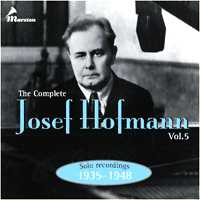
|
The Complete Josef Hofmann: Solo Recordings (1935-1948)
COMPLETE TRACK LISTING LINER NOTES ABOUT THESE RECORDINGS Josef Hofmann is considered by many of his peers to be the greatest pianist of his time. This 2-disc set, with notes by Harold Schonberg, chronicles Hofmann's career later in life containing material never before heard on CD. |
|
|
|
|

About These Recordings
By the mid 1930s Josef Hofmann was regularly receiving inquiries from the world's leading record companies - would he be interested to make some records for their label? In most cases he didn't even bother to respond directly but had his manager, Richard Copley, send a one or two-sentence response to the effect that, thank you very much, Hofmann wasn't interested. If there is some piece of documentary evidence which conclusively explains why the pianist didn't want to make records, we haven't located it, and we can only speculate. Certainly in 1935 he was thinking about recording and releasing records, as the two groups of test recordings he actually made for HMV and RCA confirm. In fact, Hofmann later cited the HMV tests as particularly worthwhile examples of his playing. Many years later, EMI Ltd., parent company to His Master's Voice, thought about including these Hofmann discs in a volume of its LP series, "Great Recordings of the Century." Transfers were made from the original metal masters, but the proposed disc was never issued. As was that company's custom then, the masters were destroyed; the transfers here were taken from Hofmann's own carefully-preserved set of test pressings.
During the next few years his personal and professional life, then at the pinnacle of achievement, quickly and amazingly disintegrated. His wife's deteriorating condition and the sabotage he suffered at Philadelphia's Curtis Institute of Music were the main events which led him to a series of nervous and other breakdowns from which he never recovered. Through all this, paradoxically, his mind never wandered far from the idea of recording, and he made one test recording each for many different commercial record companies, always the same "selection," the test-pattern which contained several different kinds of piano writing in a short space. The piano sound captured on each of these test records is often exemplary, as on the Columbia example we issue here, but that didn't serve to seduce Hofmann into the recording studio. It was almost as if the pianist were more interested in the scientific problems of capturing piano tone, the most ephemeral of musical sounds, than in preserving his own playing. In his final years Hofmann experimented obsessively with differing and imaginative schemes for improving the sound of piano recording, making hundreds of amateur acetate recordings in his Los Angeles home, invariably of the same "test-pattern" - except for the one instance of the disc of the Gluck "Mélodie" from Orfeo ed Euridice.
By its uniqueness we can assume that the pianist/experimenter felt he had arrived at some point in his research worth preserving, and the unusual acoustic in which the performance is captured does seem particularly suited to the kind of super-legato, ethereal tone-spinning Hofmann gives the "Mélodie." Nor does the acetate disc bear, like many of the other home-made Hofmann acetates, any information about the details of the experimentation - perhaps the microphone was bolted to the sound board as in some of the other experiments Hofmann tried. The disc is not dated, but due to the physical appearance of the disc and to our ears, we believe it was most probably recorded in the late 1940s or even the early 1950s, disproving the canard often encountered that Hofmann lost his abilities and could never really play well again after the mid 1930s. He certainly could, if he was in the mood and sober.
Unfortunately for posterity, he was in particular distress on several of the later occasions when he broadcast for the Bell Telephone Hour. There were eight Hofmann Telephone Hour appearances between March 1, 1943 and the last on January 13, 1947, the bitter end of the pianist's career. Also, there was a promotional Bell Telephone/Hofmann film made in 1945 with some of the same selections but different performances from the broadcasts. On most of the later Telephone Hour broadcasts he should not have appeared. Adding to the unsatisfactory nature of the mostly prosaic, unmagical and even sometimes shockingly slipshod playing is the devastation wrought by the close microphone placement and excessive limiting which rob Hofmann in these recordings of his dynamic range, perhaps the most remarkable feature of his playing. Here everything sounds mezzo-forte, and no subsequent engineering can replace what has been lost. In this volume we have included seven selections from these Telephone Hour appearances.
We end this note on a dream: Just before his final problems began Hofmann was regularly broadcasting for other sponsors and perhaps some of these broadcasts were recorded - we hope someone someday locates such acetates - for instance, it would be important to find discs of the January 24, 1937 Ford Sunday Evening broadcast on which he played Liszt's Polonaise in E Major and the 12th Hungarian Rhapsody. Each year that passes dims these dreams, and there has been no "find" of Hofmann off-the-air recordings for more than ten years. Perhaps one could sponsor a project to search out such recordings of Hofmann and several other great artists of the time, and who knows, the discs thus uncovered might pass into the hands of enlightened guardians of history's musical heritage and see wide distribution, actually serving to illuminate and perhaps delight the public and posterity!
© Gregor Benko, President of the International Piano Archives, 1997
© Ward Marston, 1997